


|
 |
|
|
#1 |
|
Registered Member
Join Date: Jul 2005
Location: Tampa, FL
Posts: 78
|
20 Gallon nano build (learning experience)
So here’s the deal. I began building my 20 gallon all-custom reef setup about 4 years ago. The project has since been dismantled because of several major mistakes I made along the way.
I owe a lot to the reef central community, and a good majority of the things I actually did right (as limited as they may be) were a result of learning from the mistakes of other humble reef keepers. So the goal of this thread is to share my learning experience in the hope that someone else may also learn how to avoid the mistakes I made, the easy way (by watching me screw it up). For those who have valuable insight to add as I story-tell here, feel free to jump in as that is what this is meant for. So that being said, this does differ from other build stories as I already know the ending which allows me to point out the mistakes as they happen. Since this was an old project, my memory is foggy when it comes to some details though, so I appologize. This is also my first thread and I’ll be learning the whole adding photo process and such along the way so bear with me. |
|
|

|
|
|
#2 |
|
Registered Member
Join Date: Jul 2005
Location: Tampa, FL
Posts: 78
|
I’ll attempt to move at a moderate pace to allow anyone interested to post their input as well.
Let me begin with mistake #1: Discovering those cool looking colorful fish on the other side of the LFS. I will forever be a slave to my love of aquarium keeping, no matter how many mistakes I make along the way, and it WILL cost me a fortune, but it is what it is. I know I am preaching to the choir here but I love the entire reef keeping hobby. What I love about it is the joining of the artistic beauty of nature with the development of technology to allow us to bring out its full potential in our own homes. It is however important to me to maintain that aesthetic appeal with a very clean looking setup. I have had the aquarium before with cords hanging out everywhere and visible filters that make gargling noises and I wanted something more suited to my long term desires: • an entirely self contained, aesthetically appealing system • could potentially be moved without bringing 30 of my closest friends over • buildable at a relatively low cost • could still function like a true reef aquarium Now that all sounds beautiful but the marriage of these concepts (and more that I would develop along the way) became more difficult than I had expected. Which brings me to my mistake #2 that I think every serious reef keeper can agree with. NEVER underestimate the time and money involved in getting the entire aquarium up and running the way you want. No matter how much you plan every single tiny component of your aquarium, there will still be tons of supplies, projects and fixes that you come across, so plan a large margin. Since I wanted this all inclusive setup, I realized I had two options. One was the nano cube style aquariums but I had been down that road before and I’ll explain along the way how that influenced some of my design. Option 2 was to do a custom build, which I persued. I could have utilized some of the custom stand and aquarium construction companies out there but that violated the goal of low cost (or so I thought at the time). I began drawing out my design for the stand. The idea began as a simple stand with a tank on it and a sump inside. Then like everything else, I got greedy with the features I wanted. This would have been fine had I planned everything better but as far as the stand was concerned, everything turned out fine, for the most part. Unfortunately I don’t think I have any build process pictures of the stand itself, which is unfortunate. 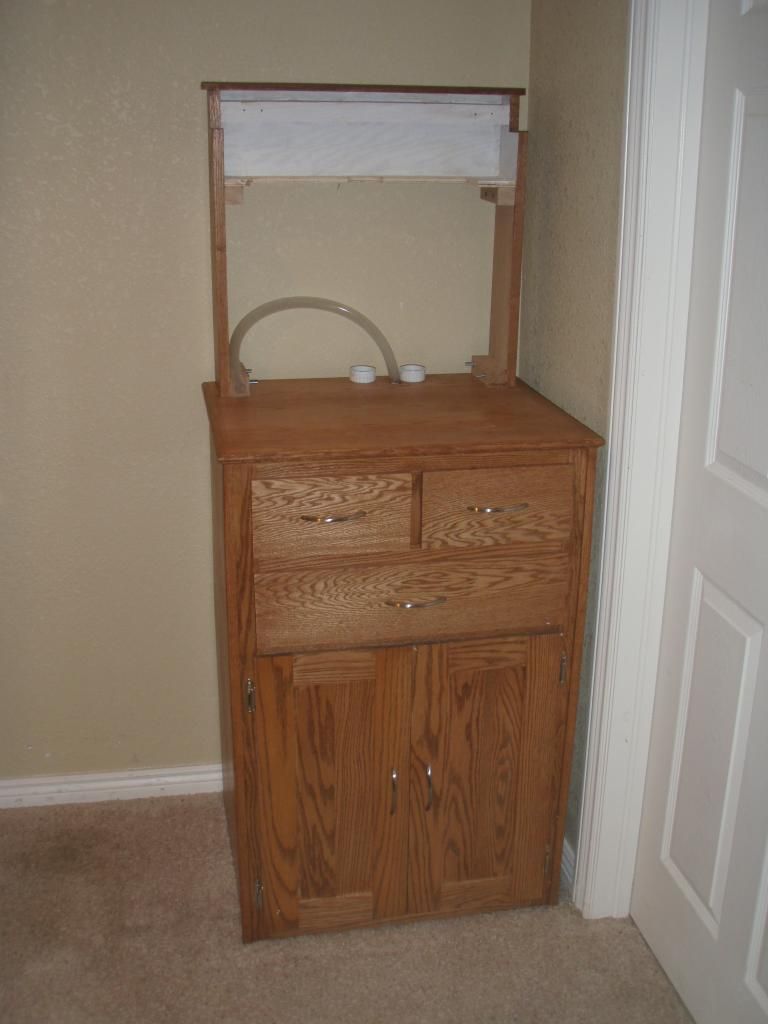
|
|
|

|
|
|
#3 |
|
Registered Member
Join Date: Jul 2005
Location: Tampa, FL
Posts: 78
|
This is the basic idea of the stand. It is a 2x4 underlying frame covered in oak finishing wood and trim. I chose this style simply because it matches a lot of my other furniture. The two vertical panels on the back (on top of the stand) allowed the plumbing to be hidden from view on each side, and attached to the hood that would hold the lighting. The white wood on the top was put into place to keep most of the light produced from escaping and illuminating the wall behind the stand. The setup has a full hood, but was not attached in this picture as it needed to be supported by the stand to avoid putting too much stress on the hinges.
The three drawers were an addition to the design to allow for the “all-inclusive” storage of all the extra supplies for the tank. The two smaller drawers were standard “bathroom drawer” style slides as I would call them but the larger drawer was a heavy duty ball bearing slide that was quite a bit more expensive but I would highly recommend if you can. It allowed me to store some heavier stuff in there without overloeading the rollers, and it opened and closed like a dream. The bottom cabinet doors housed the sump along with the reefkeeper 2 controller and some supplements and additives as well. This was also mounted with the ball bearing sliders so it slid out like a normal drawer but it sat vertically. 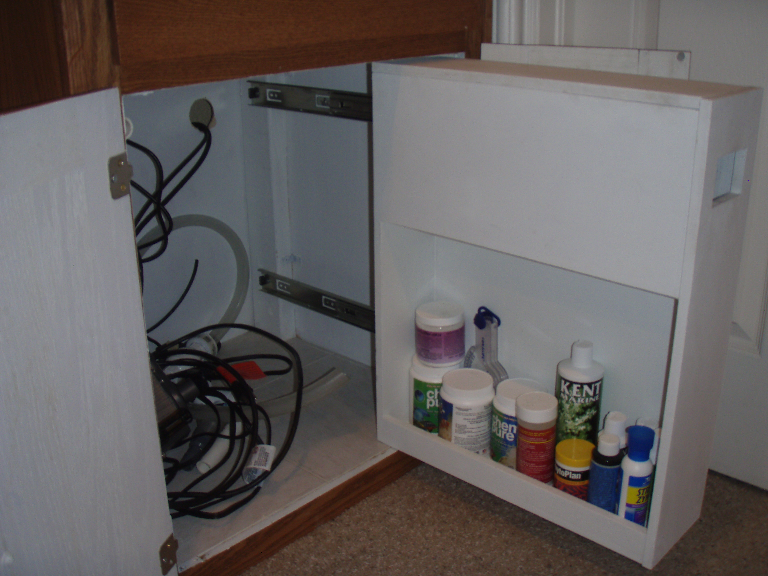 The inside of the stand was painted with a few coats of Killz to help protect against salt spray and water damage to the wood. As a nice touch, since I had extras sitting around, I put quick application linoleum tiles on the bottom which made cleaning up water a lot easier. On the top on the stand you may notice 2 white circles on the surface. Those were “quick disconnect” fittings that would allow my to basically plug the tank into the stand, or remove it if cleaning or mainenance were needed. One let to the sump while the other was the return line. This seemed like a useful idea at the time but presented some problems later. |
|
|

|
|
|
#4 |
|
Registered Member
Join Date: Jul 2005
Location: Tampa, FL
Posts: 78
|
The system was actually designed around a standard 10 gallon glass aquarium (since they were cheap and I knew I could afford to screw up drilling the tank). I purchased the appropriate diamond hole saws to allow me to cut through the glass for return lines, which worked great. I connected the aquarium with all the appropriate plumbing for the OM squirt before connceting it to the stand. Once all the plumbing was in place on the tank though, the glass would crack when being connected to the “quick disconnect” fittings on the top of the stand since they had to be screwed in to each other. After modifying my approach without success, and subsequently cracking 2 other 10 gallon tanks, I decided to go all out and build a completely home made acrylic tank.
This new approach would allow me to add the custom external overflow that I really wanted while giving the tank more flexibility to be hooked up to the stand without cracking the tank itself. I ordered the ¼” panels necessary for the 10 gallon aquarium construction, along with all the other essential equipment. This included a special saw blade meant for cutting through acrylic ($70 blade if I remember correctly), the required acrylic solvent, and many grades of sandpaper to get the edges smooth enough to attach to each other. |
|
|

|
|
|
#5 |
|
Registered Member
Join Date: Jul 2005
Location: Tampa, FL
Posts: 78
|
I realized after acquiring all the plastic that I could easily upgrade to a taller tank (wider or deeper wasn’t an option since the stand was designed for a 10 gallon). All the taller tank would require was replacing the “posts” for the hood with taller ones. After researching, I found that ¼” acrylic was too thin for a 20H and 3/8” was suggested but I figured that could be worked around with braces. I was wrong and you’ll see the consequences later.
It is always nice through the construction process to try to imagine what it will look like when eventually done so I took the acrylic sides once they were cut and stood them in place under the hood to see. 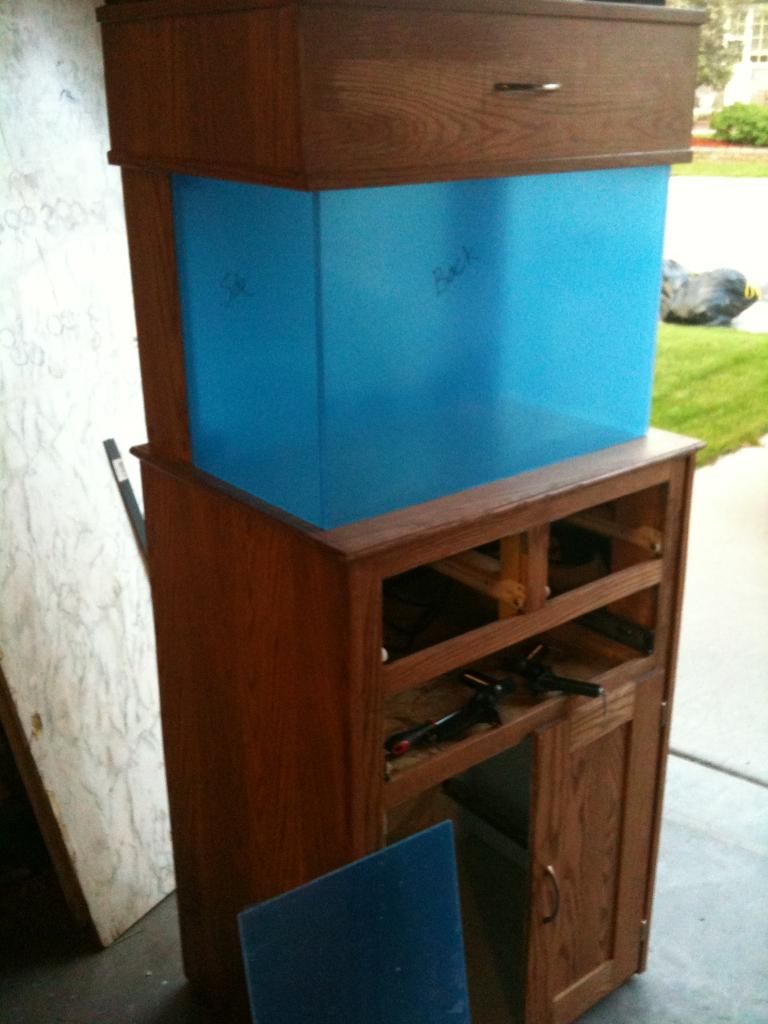
|
|
|

|
|
|
#6 |
|
Registered Member
Join Date: Jul 2005
Location: Tampa, FL
Posts: 78
|
I was definitely excited about the new prospect of the external overflow, so I used a router with a section of particle board that I cut allowing me to make perfect overflow teeth. Taking into account the width of each cut, I cut to the appropriate depth and spacing between cuts.
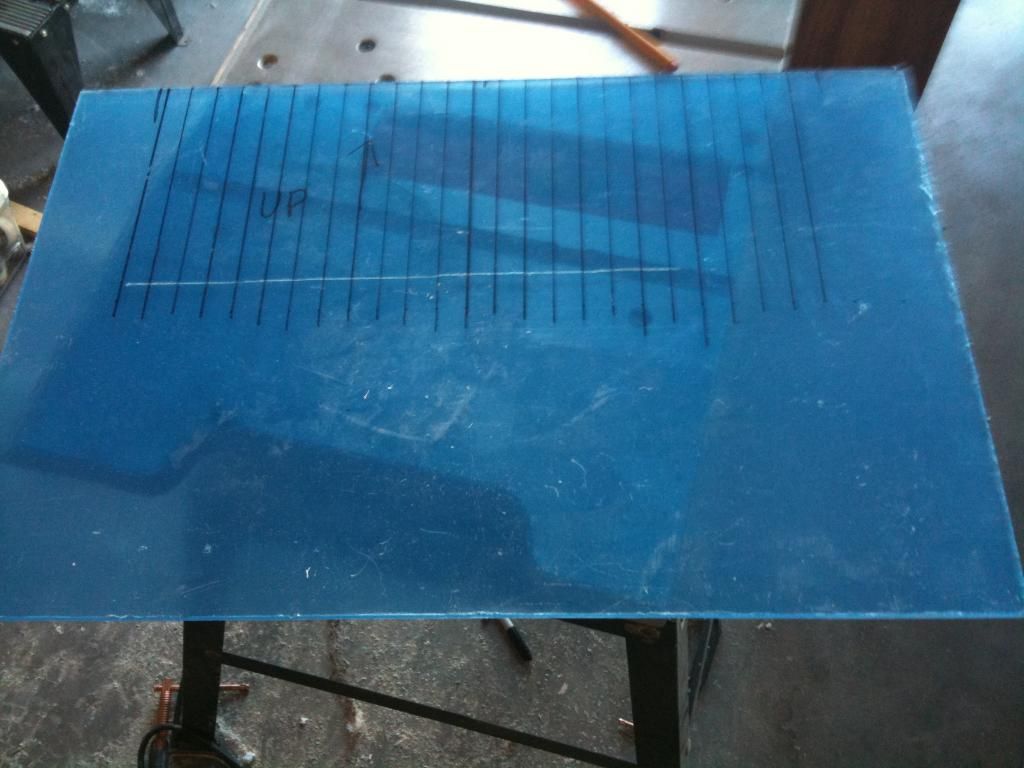 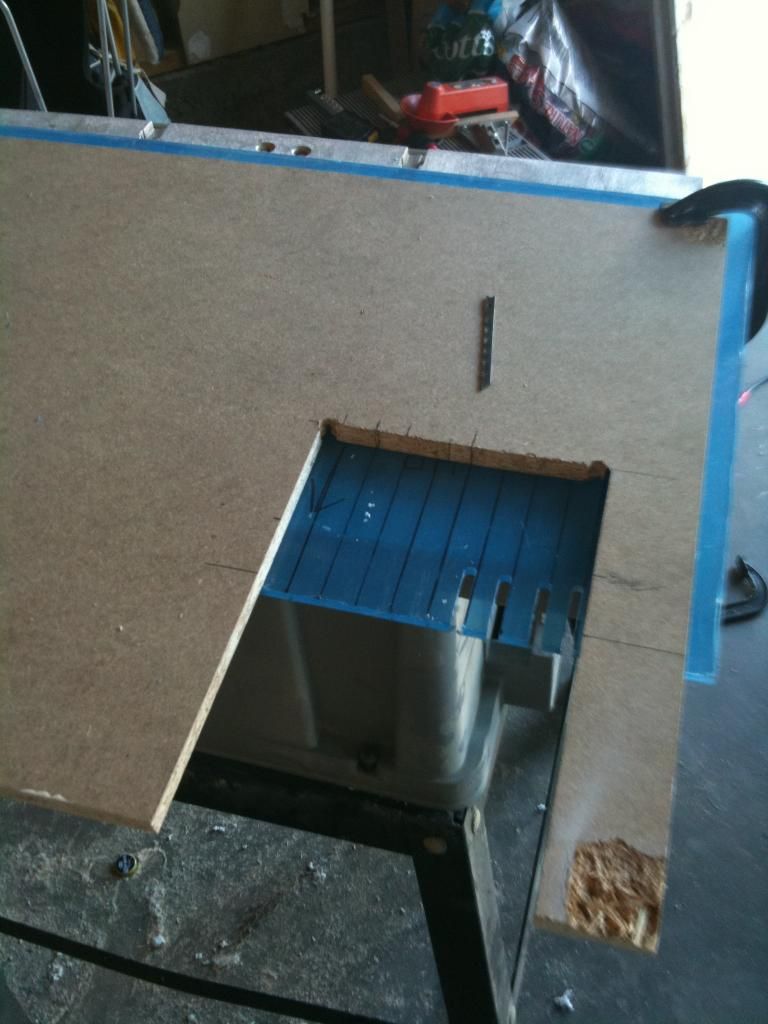 After attempting to cut the acrylic with a router bit, it began breaking the teeth off (the ¼” acrylic was not helping that, but probably imperfect cutting technique as well). So I decided to switch to a method I was more proficient at, cutting the teeth with the table saw. Since the cuts would be more narrow with the table saw, they needed to be deeper and closer to each other. 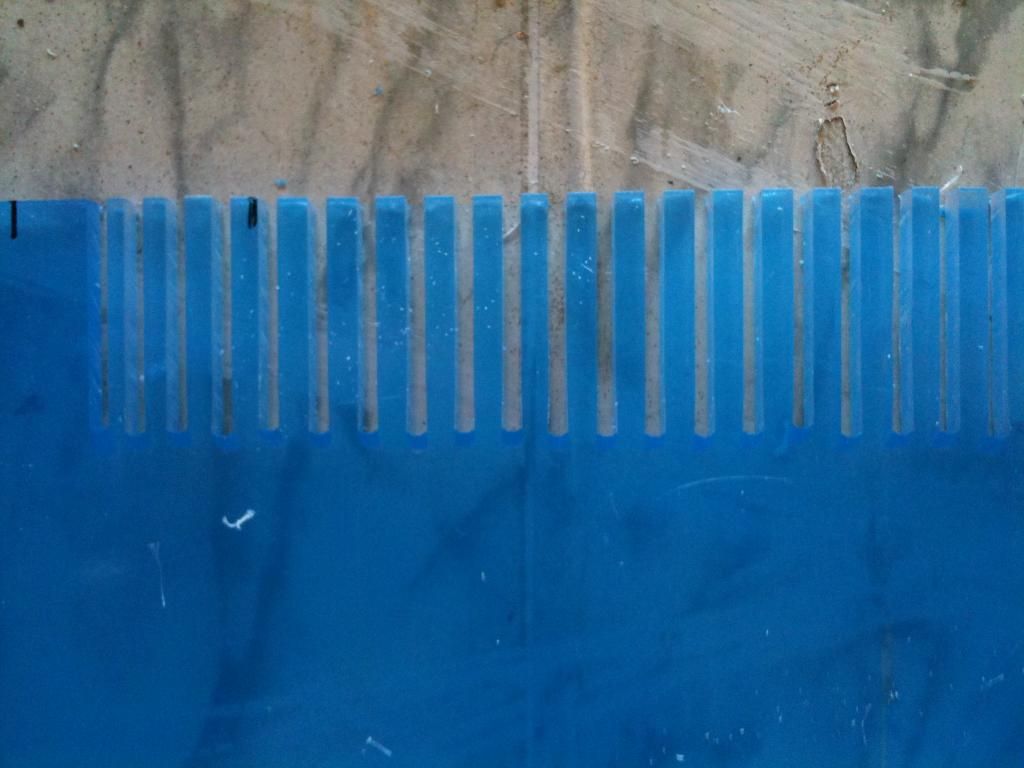 This presented a problem when the tank was completed though. The narrow cuts often kept algae on the surface of the water from going through the teeth where it could go to the filter. Instead it floated on the surface up against the teeth, gaining abundant sunlight for extra growth and obscuring the light for the tank below. This did not help the limited maintenance goal, as the algae on the surface needed to be manually removed about every other day. Last edited by COreef8; 10/20/2013 at 11:25 AM. |
|
|

|
|
|
#7 |
|
Registered Member
Join Date: Sep 2013
Location: Ohio
Posts: 256
|
Definitely going to follow this thread COreef!
 I just started a 20 gallon tall setup as my first SW tank and am still in the "learn all the things!" phase hehe I just started a 20 gallon tall setup as my first SW tank and am still in the "learn all the things!" phase hehe
|
|
|

|
|
|
#8 | |
|
Registered Member
Join Date: Jul 2005
Location: Tampa, FL
Posts: 78
|
Quote:
|
|
|
|

|
|
|
#9 |
|
Registered Member
Join Date: Jul 2005
Location: Tampa, FL
Posts: 78
|
Let me backtrack for a moment and explain the wood used with the stand for those of you who are unaware of this detail but want to custom build a stand.
Like I said, the underlying frame is simply normal 2x4 and in some places 2x2 and 1x2. I had a couple options for the finishing wood on the outside. One option is completely consistent, “true” solid oak, while the other is simply different layers of wood, glued together, with a thin outside layer of oak. The latter is much cheaper and lighter as you might imagine, so I figured it would suit my purpose. As I carefully sanded down this wood, I tried to sand as little as possible to avoid sanding through the oak finishing, but even then, I still managed to expose some defects in the wood itself, which you can see in some of the pictures of the stand, such as on the front of the hood. It didn’t stain evenly and you can see a vertical line just to the left of the handle, but for as far as I had come, I could live with that. Certainly something to think about before you get started though. The better looking wood, such as the drawers and the vertical panels behind the tank were solid oak, but again, much heavier and more expensive. More importantly, the stand surface under the tank was that cheaper “laminated” wood. I used a few layers of water resistant stain, but it is just that, water resistant. I figured that would suffice for the hopefully small amounts of water that it would come in contact with because, of course, my tank was bulletproof. As time would prove, however; the water took a major toll on the surface virtually ruining it’s finish. Make sure you go with a very highly water resistant or waterproof finishing because it WILL get wet. I’ll try to post a picture of the surface of the stand now, when I’m around the stand again. |
|
|

|
|
|
#10 |
|
Registered Member
Join Date: Jul 2005
Location: Tampa, FL
Posts: 78
|
Anyways, at this point the overflow teeth were done, the sides were cut, and I was ready to start sanding.
Remember to wear gloves when working with the newly cut acrylic. When it arrived brand new, it has usually been modified already so the edges aren’t as sharp but once you cut them on your own, they will be like razor blades. At times when I wasn’t as careful, I sustained some pretty deep cuts of my own which took forever to heal. As I mentioned before, cutting the acrylic required a specific blade, it has a lot more teeth than the average blade to avoid chipping the acrylic, and the blade is necessary. Even with the special blade, the edges come out very rough so they need to be sanded until they are perfectly smooth. Now this is where I made probably the biggest mistake of the entire project: I often sanded by hand. I’ll explain why this is a problem. As I sanded by hand, the sandpaper and the pads of my fingers would naturally wrap around the edges of the acrylic as I went back and forth. What this does over time is it slowly rounds out the edges of the acrylic, and I don’t mean the corners. It makes the edges of the panels slightly curved. When attaching a ¼” acrylic panel to another, you have ¼” of surface connecting them, all of which is needed to make a strong bond, but when attaching a slightly curved edge to another piece of acrylic, it significantly decrases that ¼” of usable surface to bond the two sheets. They will bond fine since the solvent is very strong, but the bond won’t be nearly as strong as if it was a perfectly flat surface. Here was the ultimate result of that problem down the road, and I’ll talk in detail about this later: 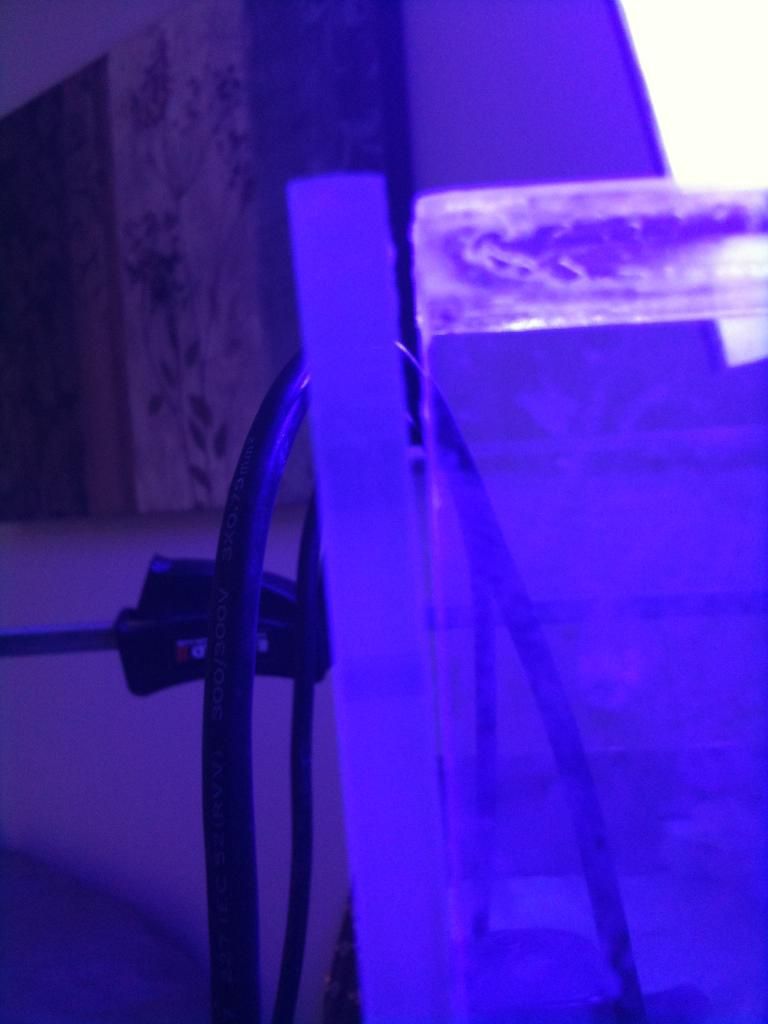 You can see the two panels beginning to peel apart as a result of 2 things: the decreased bond strength from the rounded edges, and the fact that I was using acrylic that was 1/8” too thin to begin with. Keep this in mind when working with acrylic. I was well aware of this problem, and tried to avoid it but any sanding I did by hand (without a block of some sort to keep the edges flat) began to curve the edges and decrease it's bonding strength. |
|
|

|
|
|
#11 |
|
Registered Member
Join Date: Jul 2005
Location: Tampa, FL
Posts: 78
|
You can actually see the slightly curved edge on the far left acrylic panel (the front) on the very top, for example. This was sanded even less than the other edges since it did not need to bond with anything.
|
|
|

|
|
|
#12 |
|
Registered Member
Join Date: Jul 2005
Location: Tampa, FL
Posts: 78
|
Granted I was less careful with the top edges since they wouldn't be bonded with anything but if you apply a less dramatic example of this to the other edges, you get the idea.
|
|
|

|
|
|
#13 |
|
Registered Member
Join Date: Jul 2005
Location: Tampa, FL
Posts: 78
|
Anyways, once all the edges were sanded as smooth as necessary, I began putting them together using the solvent. The process of bonding each panel is actually a bit of a science, and takes some practicing (which I did with scraps prior to using the final panels). Using the weld-on solvent, the bond was still quite strong, it merely took time once up and running for the water pressure to begin pulling the panels apart, but at first it was great.
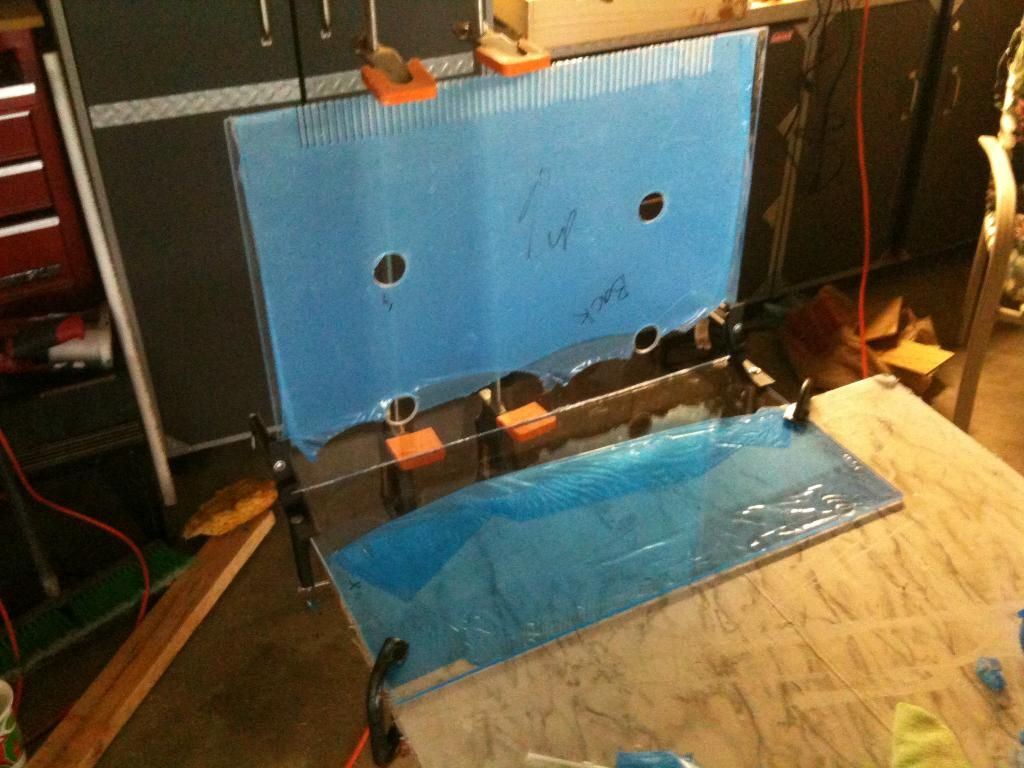 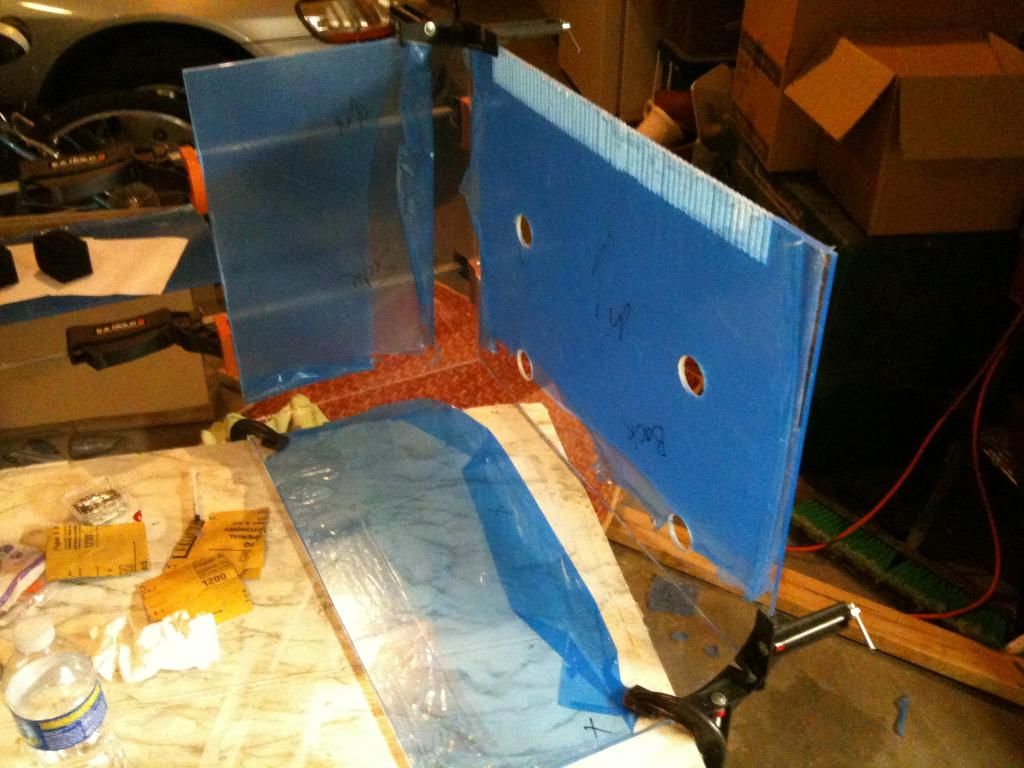 One thing to keep in mind is the way you put the panels together, as you want the water pressure pushing against the strongest bonds possible. Believe it or now, I did think about this one beforehand. |
|
|

|
|
|
#14 |
|
MantisOholic
Join Date: Jul 2011
Location: Washington DC
Posts: 1,946
|
Good info keep it coming
__________________
No there is no such thing as over filtering a tank. Slow is smooth, smooth is steady, and steady is fast. Current Tank Info: Enough to be considered an addict. |
|
|

|
|
|
#15 |
|
Registered Member
Join Date: Jul 2005
Location: Tampa, FL
Posts: 78
|
The holes for the returns from the OM squirt were predrilled, so once the panels were assembled, bulkheads secured, and it had a few days to set, it was time for a water test.
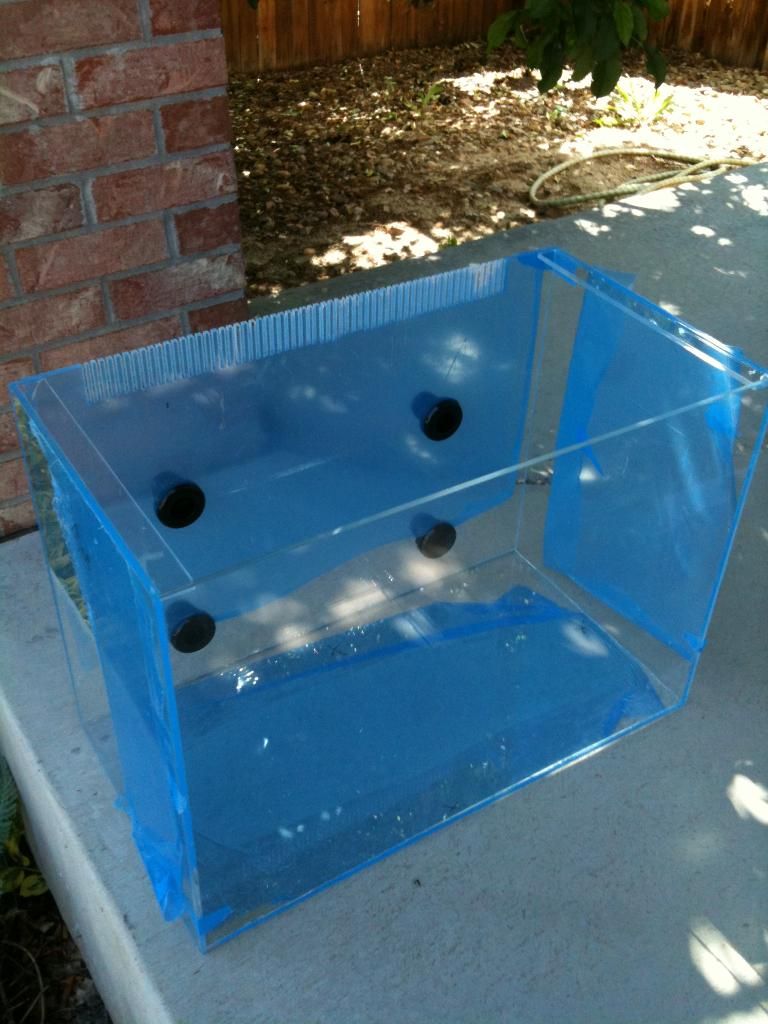 Since the bulheads would not allow me to fill the tank up, I threw together some PVC that sat higher than the water level so I could test it. 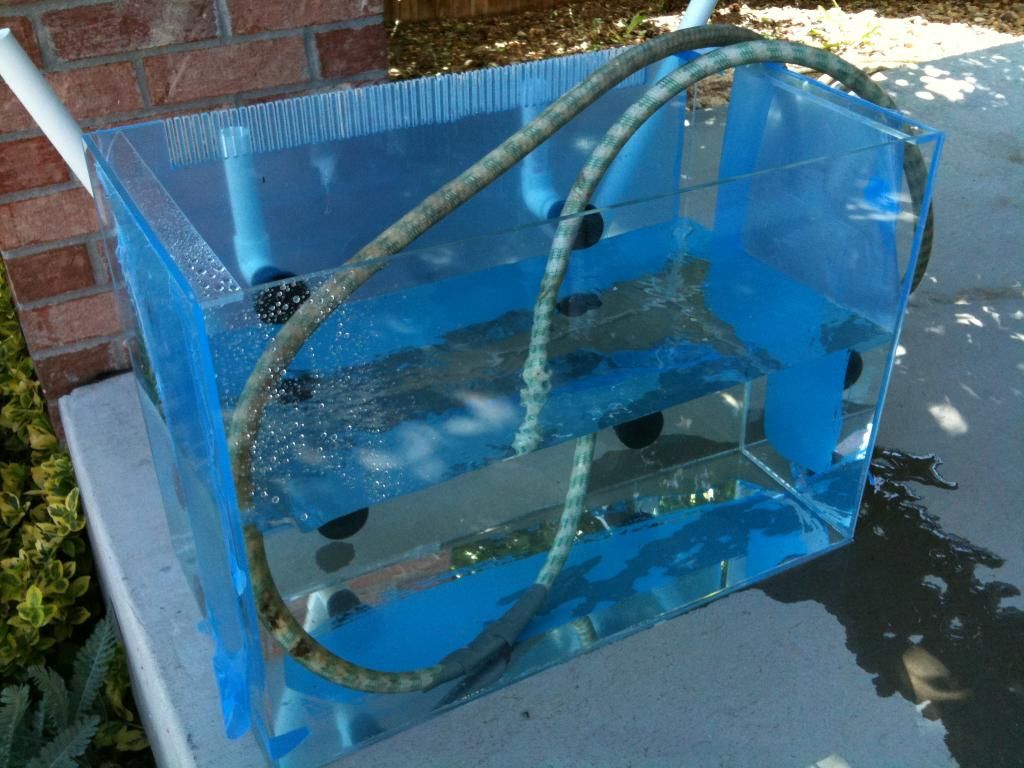 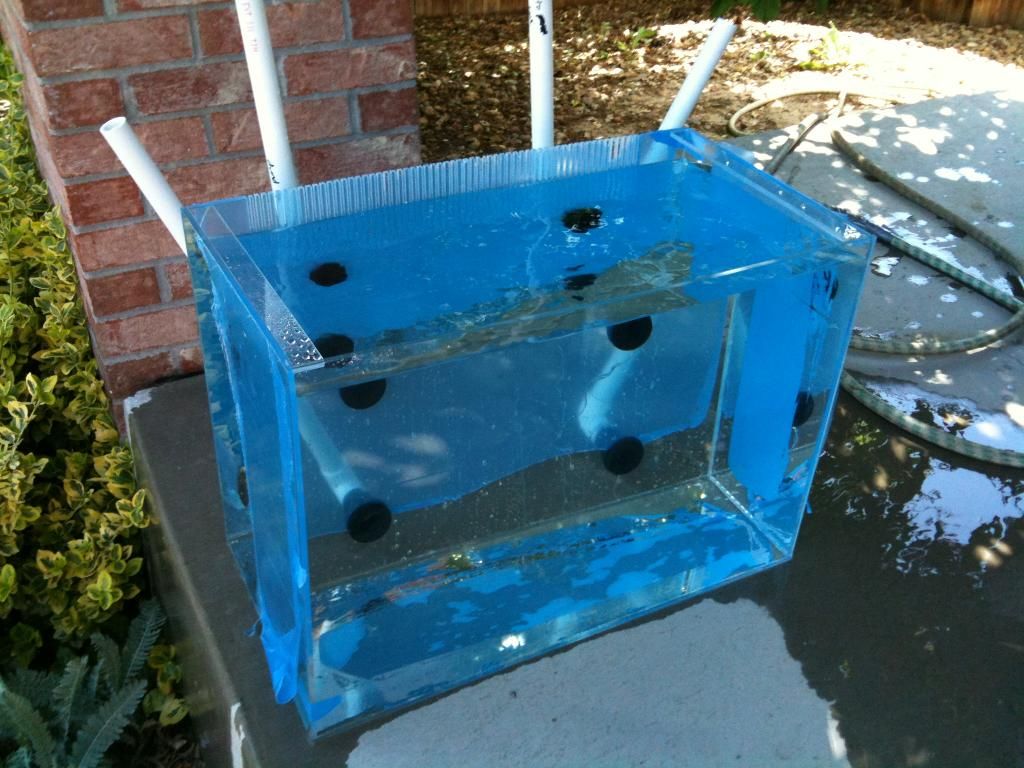 If you look closely at the last picture, you may be able to see the front and back panel beginning to bow. This was a consequence of using the ¼” acrylic as opposed to the 3/8” as suggested. This was a major contributor to the separation of the panels down the road as well. |
|
|

|
|
|
#16 |
|
MantisOholic
Join Date: Jul 2011
Location: Washington DC
Posts: 1,946
|
Can't wait to see the overflow box and how you attached it
__________________
No there is no such thing as over filtering a tank. Slow is smooth, smooth is steady, and steady is fast. Current Tank Info: Enough to be considered an addict. |
|
|

|
|
|
#17 |
|
MantisOholic
Join Date: Jul 2011
Location: Washington DC
Posts: 1,946
|
Did it aid with the bowing in the back or did that separate caused by the bowing?
__________________
No there is no such thing as over filtering a tank. Slow is smooth, smooth is steady, and steady is fast. Current Tank Info: Enough to be considered an addict. |
|
|

|
|
|
#18 | |
|
Registered Member
Join Date: Jul 2005
Location: Tampa, FL
Posts: 78
|
Quote:
Hopefully that answers your question. |
|
|
|

|
|
|
#19 |
|
Registered Member
Join Date: Jul 2005
Location: Tampa, FL
Posts: 78
|
As far as the back panel was concerned, the plumbing attachments were pretty much my saving grace.
|
|
|

|
|
|
#20 |
|
Registered Member
Join Date: Jul 2005
Location: Tampa, FL
Posts: 78
|
This is where another general mistake occurred: If you see something wrong, or AT ALL abnormal, it will only compound itself down the road. Reef keeping, being such a precise science requires precision in everything. While there are margins for error, these margins should only have be counted on in situations beyond my control, but despite this early warning sign, I continued the project hoping my solutions down the road would suffice. Needless to say, in the long run, they did not. This would have been the best time to take some major action.
On that happy note, after the “successful” water test, I secured the external overflow using the same method as the rest of the panels. I let it set again, and proceeded with another water test. 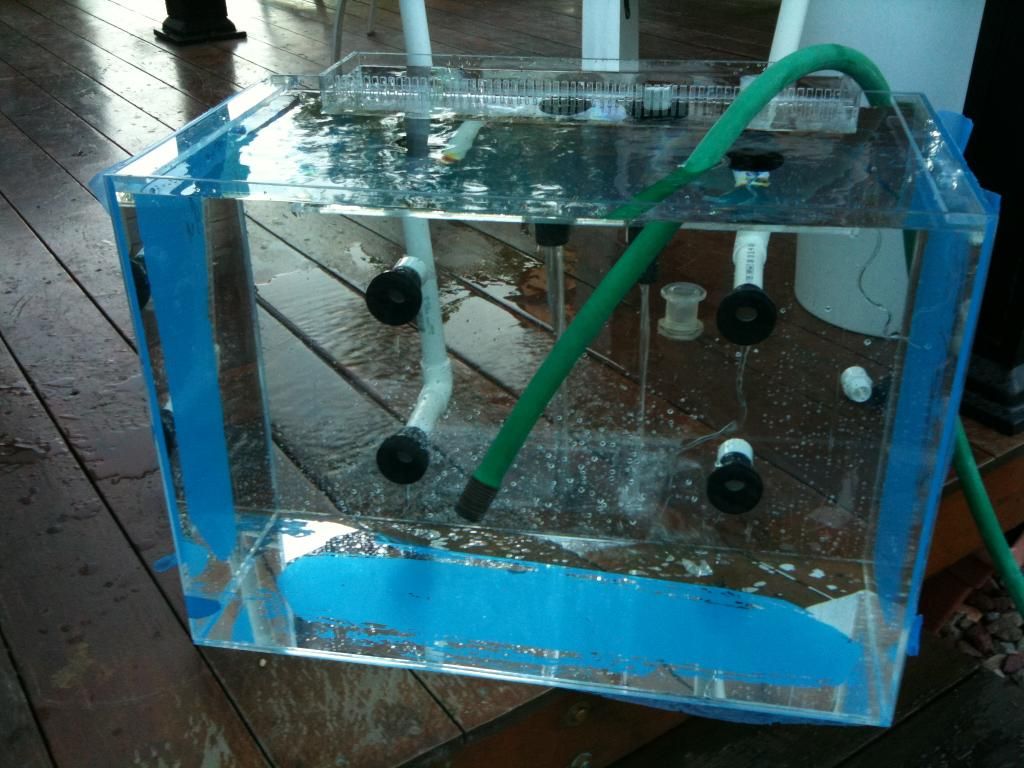 Any leaking you see on the back of the tank was not a mistake/issue. I simply slid the pvc onto the bulkheads without any solvent, just enough to be able to fill the tank and test the overflow box. The box itself worked great. It took fine tuning, like any overflow, to avoid the gargling noises. Again, it was the overflow teeth that were an issue in allowing the surface algae to be removed. Despite my imperfect sanding technique, this was not a problem for the overflow box itself since it contains so little water pressure that it did not cause separation from the tank. Being attached to the tank itself, actually helped to stop some of the bowing on the back panel since it acted a bit as a brace. I would highly recommend and external overflow if you have the means. |
|
|

|
|
|
#21 |
|
Registered Member
Join Date: Jul 2005
Location: Tampa, FL
Posts: 78
|
The next step was to paint the back of the tank. I personally like the black background better. I used a special paint used for plastics to avoid any peeling down the road. I know some people will lightly sand the acrylic so the paint will grip better, but for whatever the reason, sanding perfectly good acrylic felt wrong after I had spent so much time sanding and polishing the edges. The paint worked well, I never had any peeling issues.
You also get a better view of the external overflow from the painting pictures as well: 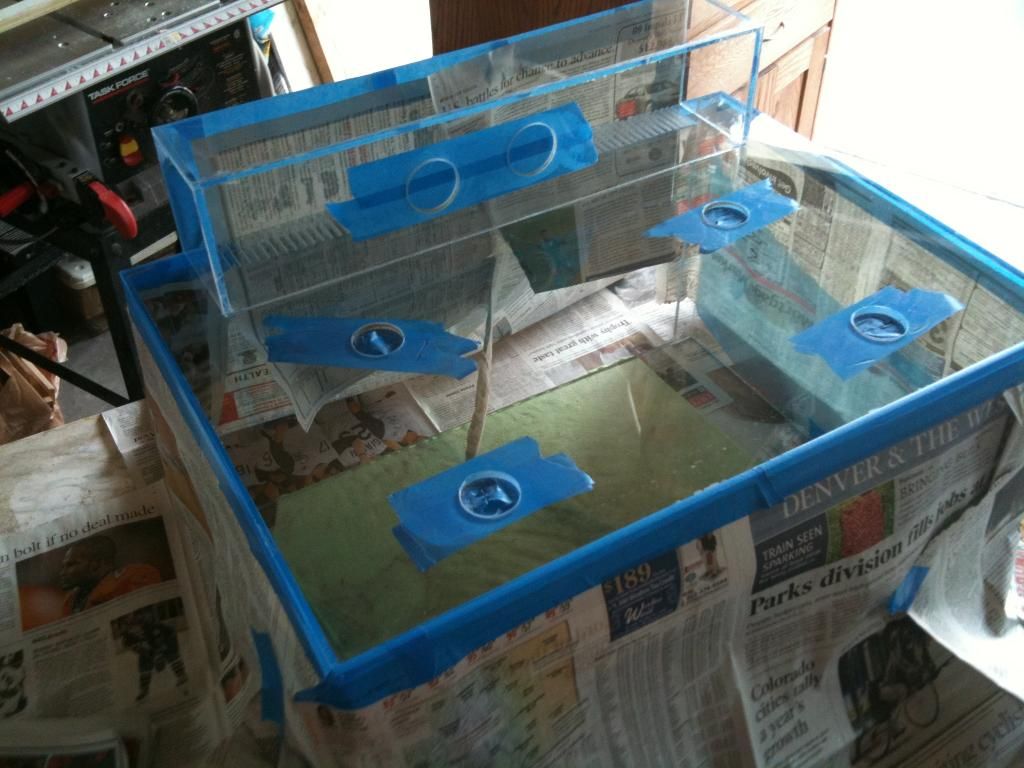 Again, once it was painted and dried, I put it on the stand to see what it would eventually look like. 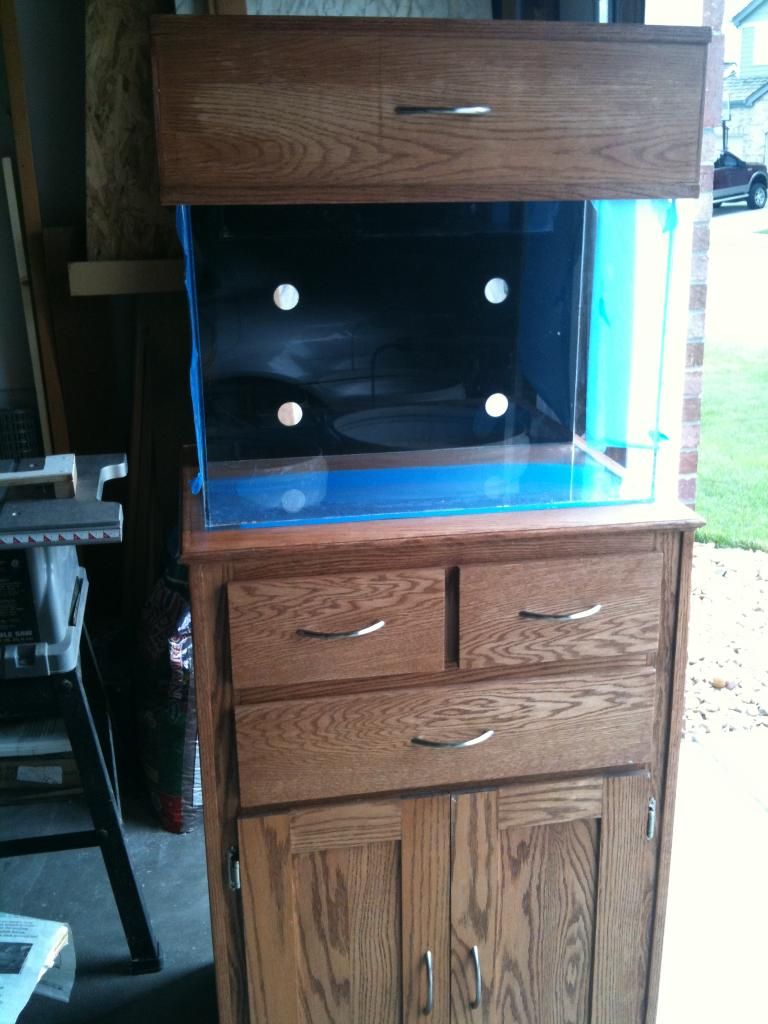
|
|
|

|
|
|
#22 |
|
Registered Member
Join Date: Jul 2005
Location: Tampa, FL
Posts: 78
|
One thing I did not initially like was the large hood size compared to the rest of the setup. This was actually dictated by the size of the 24" retrofit lighting system I had from a previously abandoned project. So if at any point during the rest of this build you're thinking that some of the components seem like overkill, it's because they weren't originally planned for a 10 or even 20 gallon system.
But in the interest of saving as much money as practical, this seemed like the best way to go. |
|
|

|
|
|
#23 |
|
MantisOholic
Join Date: Jul 2011
Location: Washington DC
Posts: 1,946
|
Keep posting I am activlly learning/relearning to take time and fix what seams wrong. What seams wrong should never be left un fixed. Why did you not euro brace the front panel? And do you think this would have helped with the delegation issues you had? Also do you think if you had reinforced the corners of the tank with small strips of acrylic welded to the inside seams would have prevented the seperation?
__________________
No there is no such thing as over filtering a tank. Slow is smooth, smooth is steady, and steady is fast. Current Tank Info: Enough to be considered an addict. |
|
|

|
|
|
#24 | |
|
Registered Member
Join Date: Jul 2005
Location: Tampa, FL
Posts: 78
|
Quote:
|
|
|
|

|
|
|
#25 |
|
MantisOholic
Join Date: Jul 2011
Location: Washington DC
Posts: 1,946
|
Or just thicker sheets and better preparation on the sanding. I wounded how fast this would have failed with a wave action from an mp. I saw a 300 pull the center brace out after a wave box was added to the tank for 3 weeks.
__________________
No there is no such thing as over filtering a tank. Slow is smooth, smooth is steady, and steady is fast. Current Tank Info: Enough to be considered an addict. |
|
|

|
 |
| Tags |
| acrylic aquarium, build thread, nano build |
|
|